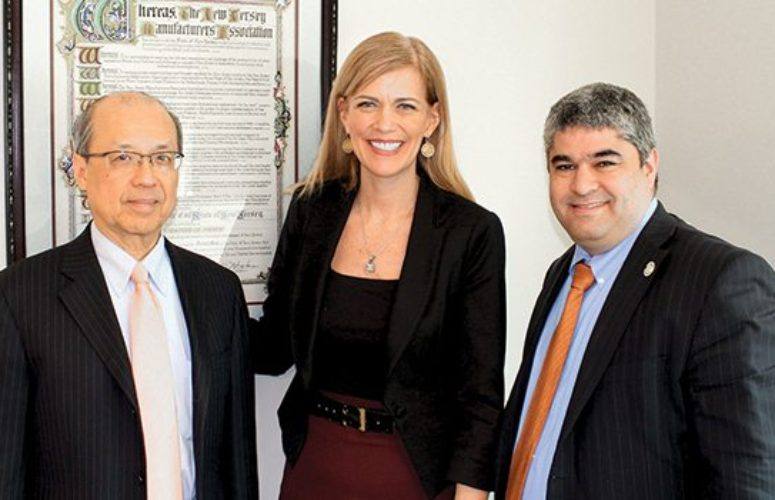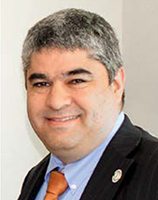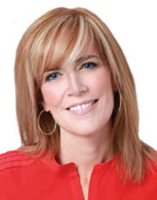
Minorities Have a Major Impact
A Q&A on how minority businesses are succeeding in the USA.
By Anthony Birritteri, Editor-in-Chief On Apr 11, 2016In this installment of New Jersey Business magazine’s quarterly Trade-Talk Roundtable discussion, we sit down with executives from some of the state’s leading minority chambers of commerce, plus one women’s business organization, to gauge the successes, challenges and hopes of their respective members. Yes, this country is a melting pot, but obtaining fairness and equality – in all facets of life – is still a problem for some groups. Below are the biographies of our participants, with a brief synopsis of the organizations they represent. The Q&A on business issues begins on page 57.
Particpants:

The SHCC-NJ, with some 2,500 members, traces its roots back to 1989. The chamber says it represents the voice of 80,000-Hispanic-owned businesses in the state that contribute more than $12 billion to the New Jersey economy. Among the chamber’s mission and many objectives is: to provide technical and educational assistance to small businesses, professional associations and entrepreneurs through meetings, seminars and conferences; to strengthen and expand the network of Hispanic and professional business associations; and to influence legislation, policies and programs that have an impact on the small business community.
According to De La Hoz, the number of Hispanic-owned businesses in the US exploded these past 14 years from 1.6 million in 2002, to more than 4 million in 2015. These businesses contribute $661 billion to the US economy.

The AACCNJ is dedicated to the business development and economic empowerment of American society, particularly the African-American communities in New Jersey. While providing a platform for New Jersey’s African-American business leaders to speak with a collective voice, the AACCNJ also advocates and promotes economic diversity.
According to Harmon, there are 1.2-million African-American residents and approximately 66,000 African-American-owned businesses in the state. From 2002 to 2007, the number of African-American-owned businesses, on a national basis, increased by 60.5 percent to 1.9 million, according to a US Census Bureau survey. These businesses employed 921,032 people, and their payrolls totaled $23.9 billion. Over the same period, receipts generated by black-owned businesses increased 55.1 percent to $137.5 billion.

The NJCACC is an organization dedicated to: promoting business between members; helping Chinese-American businesses and professionals enter the mainstream American economy; and facilitating US/China trade. Throughout the year, NJCACC hosts networking events and seminars/workshops that are helpful to members and prospective members.
According to Lau, there are some 150,000 Chinese residents living in New Jersey. According to the US Census Bureau, there are 67,755 Asian-owned businesses in the state (2007 – latest available data). It is important to note that this number also includes all Asian populations: Asian-Indian, Chinese, Filipino, Japanese, Korean and Pakistani.

Tracing its roots to 1994, The AICC’s mission is to meet the entrepreneurial and business needs of New Jersey’s Asian-Indian Community. AICC provides: a forum for networking; information and research to enhance member success; and encourages participation in the American political process. The organization has more than 200 members, but has an outreach to some 1,000 Asian-Indian small businesses.
Based on 2010 US Census data, the state’s Asian-Indian population is 292,256. According to a 2015 report released by the Confederation of Indian Industry and Grant Thornton, New Jersey was No. 1 among the top five US states in which Indian companies have generated maximum employment: 9,278 jobs in 2014. New Jersey was also among the top five states in which Indian companies contributed the most in terms of foreign direct investment: $1 billion.

Prior to forming LWE, Wellbrock co-founded Own It Ventures, where she held high-visibility conferences and forums to enable women entrepreneurs to gain an education and make the connections to move their professional goals forward. She spent several years in the publishing industry, serving as vice president of business development and associate publisher for a professional women’s publication.
In New Jersey, a 2014 report by American Express OPEN estimates that the number of women-owned businesses grew 48 percent between 1997 and 2014. The state’s 230,000 women-owned businesses employ nearly 260,000 people and contribute $45 billion to the economy.
Q: Can you tell me about your organization, including its mission and services?
Wellbrock: Leading Women Entrepreneurs recognizes and showcases the top women leaders in the greater New York/New Jersey area. We do this through the media, our membership, events, educational resources and retreats. The mission is to showcase stories of success to empower the next generation of leaders. We also help successful women leaders gain visibility by becoming media experts.
Lau: The New Jersey Chinese American Chamber of Commerce (NJCACC) has three missions. One is to promote business between members. Two is to help Chinese American businesses and professionals enter the mainstream American economy. Three is to facilitate US/China trade. Of course, we network among ourselves. This is our primary activity.
De La Hoz: We are the Statewide Hispanic Chamber of Commerce of New Jersey (SHCC-NJ). Founded some 26 to 27 years ago, we represent the voice of 80,000 Hispanic-owned businesses that contribute $12 billion to the New Jersey economy.
In the past three years, we have grown almost 500 percent and currently have 2,500 active members. In the past 10 to 15 years, the number of Hispanic business owners exploded. Without Hispanic businesses, I have heard it said that the US economy could not have recovered as fast as it did [after the recession].
We help individuals start and grow their businesses, and we also help them reach the general market. We also help other organizations reach out to the Hispanic market, especially nonprofit organizations that we see as a good value for our community.
Harmon: The mission of the African-American Chamber of Commerce of New Jersey (AACCNJ) is to position our constituency so it could get an equitable stake in New Jersey’s prosperity; so that children get a quality education, that parents could get meaningful employment in order to sustain their households, and that business owners could have access to opportunities in both the public and private sectors. This is not about giving anyone anything. It’s about leveling the playing field to compete.
Pandya-Patel: Our platform is to work with small business entrepreneurs within the New York, New Jersey, Pennsylvania area. Our membership is very diverse; just 70 percent of our members are Asian-Indian businesses.
The basic premise is networking and bringing different industries together. We have done some multi-international chamber networking events where we have invited chambers from different nationalities, including Chinese, African, Hispanic, Jewish, etc. We try to connect them all together.
Q: Minority-owned firms are the leading type of startups companies in the US. Can you explain why this is so? What is it about the entrepreneurial spirit within your groups?
Lau: Many Chinese-American immigrants are well educated. They have been coming here to get their masters degrees after getting their bachelor’s degrees in China. Many of them are in search of the American dream, which is a steady job. Some of them, because of their backgrounds, see America as having unlimited potential.
Many are in the technology and biotechnology arenas and start their own companies. In the past, those who did not have college degrees started businesses like restaurants and laundries.
De La Hoz: The majority of our members are micro-businesses: restaurants, beauty salons, barber shops, etc. Some people came from their native countries with no education, and they relied on cash-based businesses here. However, we have others who were born in the US. They speak more English than Spanish, and are more acculturated. They run other types of businesses: engineering firms, law firms, professional services, etc. They are also in the technology and pharmaceutical industries.
Q: Do many of the micro-business owners start their own ventures because they find it difficult to find job opportunities?
De La Hoz: Yes. A lot of industry has moved out of the US, and the people who used to work in those industries have been unemployed for more than a year. The reality is, when you cannot find a job, the option is opening a small business. In some cases, we see parents who were the first to immigrate, start restaurants or bodegas. They are actually doing very well, but their children, who went to US-based universities, don’t want to run the family business. Most of them want to be in a fancy office in a tall building because that is what society sells them. The reality is some of these children would do better running the family business.
Wellbrock: The entrepreneurial spirit among the sisterhood of very successful women is immeasurable. There is an undefined drive. There is passion that is just contagious and infectious. Additionally, women entrepreneurs account for about 40 percent of all businesses. They are growing 2-to-1 compared to our male counterparts, so this is a huge movement.
I think women start businesses for a lot of different reasons. Some do so because they have to make career choices. If they have a child and are working in corporate America, they may no longer find that environment to be conducive to being the mother they want to be. Another strong reason women start their own businesses is because they want to solve a problem in the world. If the business, for example, isn’t a nonprofit that raises money or solves a world problem, then what [a woman business owner] would do is take a mainstream product and figure out a way to be philanthropic about it. It’s the compassionate nature women have, and they can build it into an amazing business.
Harmon: According to the last two censuses, African-American businesses had the highest start-up rates. What African-Americans realize is the only way to create true wealth is by owning your own business. Some glass ceilings still exist in corporate America, so many of our folks find that starting their own business is the greatest position they can be in to better sustain a household.
Pandya-Patel: Everyone who comes to the US, for some type of start, is eager to use the skills they have. One of the biggest things [for the Asian-Indian population] is education. It is in our roots. From the first generation to the current generation, everybody focuses on education and hard work. That has been the advantage for the Asian-Indian community. It is just the upbringing we have.
I came to this country when I was two years old. My parents were in their 20s. Now, my generation is growing up and raising children, and we have to balance how our parents raised us with how we think our children should be raised. I think we have the best of both worlds because we are able to see both generations.
Q: What are you seeing in the upcoming generation that is different from your parents’ generation?
Pandya-Patel: For my generation, there is a lot more risk taking. Our parents wouldn’t take those business risks. I think the next generation is going to take even more risks.
Q: Are government and corporate set-aside procurement programs vital for your members?
Lau: You can’t participate in a set-aside [contract] until you are certified by a [certifying] agency. There are various federal programs … the Small Business Administration program is different from the Department of Transportation program, which is different from the Minority Business Development Agency (part of the US Department of Commerce) program. Then, every state has its own programs. Some recognize minority certification, and some don’t. New York is more focused on minorities. New Jersey doesn’t focus on that anymore. There are also corporate programs.
That said, many Chinese businesses here don’t know a lot about the certification groups because their skills are more technical in nature; they are more vertically oriented. So, our chamber has been trying to educate entrepreneurs in getting certified. So far, however, they just forge ahead and do their own thing.
Pandya-Patel: A lot of people in the Indian community are not aware of such programs. I guess it’s an awareness thing. I am trying to apply for a women-owned business certification for one of my businesses, but it took me many years [to find out] something like this is available. For some women-owned programs, you have to be 51 percent owned by women. There is not a lot of that in the Asian-Indian community.
For Asian-Indian businesses, they’ve been trying to do the traditional thing … just go out there and [conduct business].
Wellbrock: [For women-owned businesses] The Women’s Business Enterprise Council (WBENC) is the overall arching certification. It is more for corporate work. It opens you up to procurement opportunities. However, the consensus is that certification is not an easy process. WBENC goes in with a team to personally ensure that a business is woman-led and that the operational decisions are being made by a woman. They go through all your tax records … it is an extensive application process.
Harmon: New Jersey is the most diverse state in the nation, but while most states have diversity procurement goals, New Jersey doesn’t.
We get a little bit into partisanship here, where the African-American community, by and large, has been a huge supporter of the Democratic Party. You would think that the Democratic Party would be representing the interest of its constituency. On their watch, one of the major policies that would ensure that African-Americans would have some definitive share of the state’s procurement dollars, went away and was not challenged. That is a problem.
[The state’s women- and minority-owned business set-aside program was abolished in 2003 following a disparity study and court ruling. Today, a small business set-aside program is in place, but it is race and gender neutral. Meanwhile, the New Jersey Department of Treasury does certify women- and minority-owned businesses. The reason is so that these small firms can take advantage of supplier diversity programs offered by, for example, large corporations.]
What is positive is that the federal government programs have not changed. There are the US Department of Transportation’s Disadvantaged Business Enterprise (DBE) program and HUD section 3 goals in which 30 percent of workers on HUD section 3 construction projects must be low income individuals. [There are also US Small Business Administration certifications as well.]
The state Department of Transportation, New Jersey Transit and the Port Authority – they all recognize DBE. These agencies have to recognize and honor these goals to receive federal money. These policies came forth during the Nixon administration, following the Civil Rights Bill of 1964. Nixon, as a Republican, really drove affirmative action.
Q: Once a business is certified, are opportunities, whether corporate or government, tremendous?
De La Hoz: A lot of businesses apply and get certified, but they think that all the opportunities will come to them. It doesn’t work that way. It is a long process. It can take up to three years for a small business to be able to start doing – and keep doing – business with a government agency.
Additionally, you can be certified, but you also need the experience. Sometimes, the difficult part is having both. Usually, someone will start with small projects. A larger company, which gets an entire project, may reach out to a minority-owned business to do a small portion of the work.
Wellbrock: For a woman who recently participated on a panel discussion on this topic, just being branded as a certified woman-owned business was important. She wanted the public to know her business was being run by a woman. Taking the next step and turning that into a successful business, well … the [work is] not going to come to you. This is an enormous opportunity if you can be aggressive with it. Chief diversity officers at large corporations want to be the door openers for diverse suppliers. However, it is also like Shark Tank: They are getting applications upon applications. However, [diversity officers] can take your business from one level and explode it into a super thing.
Q: Do banks look at certification as a strong criterion when it comes to lending money?
Wellbrock: If they don’t, they should. I think it is an indicator that a company is extremely well-vetted.
De La Hoz: One of the major problems for our members is access to capital. One issue here is personal credit history. We have a lot of members who still do business in cash. They own buildings and restaurants and bodegas, but they have never applied for a loan before. Another issue is the lack of collateral. We have members who have good credit histories and good cash flow, but they don’t have good collateral to access a loan. So, for those companies that get certified and win a bid, the problem is the first round of access to capital.
Lau: The certifications would help, but from a marketing aspect only, not so much in getting real financing from banks. At the end of the day, the banks will look at your balance sheet. If you have assets to collateralize, then, yes, you will get the loan. If you don’t have it, you are out of luck.
There is an organization called the National Minority Supplier Development Council (the equivalent to WBENC), which certifies minority-owned businesses for corporations. It has a financing or business development arm that – if you are doing business with any major corporation – you could talk to them and get financing. That should be a little bit easier compared to banks. If you have a contract with a major corporation, the NMSDC could advance you money without collateral. There are organizations like this out there.
Harmon: [The African-American business community] has relationships with a number of financial institutions and micro lenders. However, you still have to qualify. You still have to have cash flow and be able to meet debt service.
Pandya-Patel: Funding in general has been a challenge for everyone, due to changes in banking requirements and the different things financial institutes are asking for. For Asian-Indians, I don’t think it is any more or less challenging than other groups.
There are people looking at outside venture capitalists and different types of non-traditional funding. There is a company we work with, called QuarterSpot, which does non-traditional loans and short-terms loans. Everyone is going out to those types of organizations because it has been hard to get approvals from banks.
Wellbrock: There are many new ways women and minorities can access to capital. We have all heard of crowd funding. There are [organizations], such as KIVA, that are dedicated to funding solely women entrepreneurs. There is Lending Tree, iLend and even PayPal has something. There are all of these interesting tech companies that are addressing the access-to-capital issue, and I think it is important for us – as organizations and chambers – to educate our members on what is available.
Q: I read that minorities of all races, ethnics groups and genders are not well represented in the C-suite. What can be done to increase these numbers?
Wellbrock: The statistic is that less than 3 percent of women are in the C-suite, so that has to change. It is encouraging to see that this conversation is becoming more and more public. Refreshingly, New Jersey is leading in terms of women in the C-suite compared to other states. I think that these conversations have to continue. There has to be mentorship and sponsorship within the corporate environment.
Regarding diversity in the board room, it is interesting. Norway, for comparison, is one of the most progressive countries in the world. About eight to nine years ago, the country put a mandate in place in which 51 percent of all public boards had to consist of women. This was an extremely radical decision. A lot of people didn’t like the idea. About eight years later, those companies saw measured revenue and productivity increases and, unanimously, everyone thought this was one of the best decisions for corporations. When the statistics prove things like this, and we – as educated citizens – know that diversity does make us more aware of what is going on in the world, these are the types of things that need to continue.
De La Hoz: We always start the conversation by asking the question, “How many Hispanics do you have on your board?” This is a tough conversation. What we want is that a business’ board is reflective of the market it is going after. That is our message. We don’t expect all major corporations to have a CEO who is Hispanic, but we are seeing some changes, like the CEO of Sprint is Hispanic. The SHCCNJ is being responsible in helping people develop the skills to become board members.
We have a group of professionals we are trying to mentor, so that when we get the call from a company about having a Hispanic board member, we conduct our own research for prospective candidates. I think the conversation is easier to have based on the region you are in. For instance, 90 percent of the Hispanic population is in cities including Union City, Jersey City, Paterson, Passaic, Elizabeth, New Brunswick, Perth Amboy and Trenton. It is easier to have the [board member] conversation in those places.
Additionally, when someone approaches us and says, “We want to respond to the Hispanic market,” we don’t want to see someone trying to oversell to our community. We want to see long-term efforts that will include a lot of individuals from our communities. We want corporations to be culturally sensitive … that they are not just celebrating Hispanic heritage month.
Lau: Most Chinese are content earning their degrees and making a comfortable living (buying a house and starting a small business or having a good professional job), but aspiring to become a board member in New Jersey, especially when high-tech industries have moved out, [is difficult]. If we were in Silicon Valley, then it would be a different discussion for Asian-Americans or Chinese-Americans.
Harmon: If [corporate] leadership sees diversity as a value proposition, it is more readily in place. I understand that in business, you may have developed good relationships with the players that sit around the board table. There is risk in bringing in new people, especially if you have something that is going well. However, the risk/reward is that you don’t know the potential of bringing on the right diverse candidate.
You may be doing well, but you can do potentially greater. As a business owner, particularly a publicly traded company, you can ill afford to minimize shareholder value. You always have to be looking at how to add more value out of your requisite representation and relationships. New ideas, new approaches; that is what you get through diversity. The AACCNJ is a resource for those operations looking to get the best value out of bringing more diverse talent to their supply chain, as well as representation of their employees.
Pandya-Patel: I think we are going to see a lot more [Asian-Indians in the C-suite]. The Indian community is working hard and they are making great strides. Because of the second generation and third generation, I think you will see a lot more Indian CEOs of large companies. We are already seeing it. It was challenging for the first generation because of the language barrier.
Q: We are in the midst of a presidential campaign. Do you have any thoughts about the candidates on both sides of the political aisle and how their platforms may impact your members’ businesses and overall livelihood?
De La Hoz: For the Hispanic community, which raised a lot of heat about Donald Trump talking about Mexicans and the border, immigration is a big issue. We don’t promote illegal immigration, but we know it is a problem that we need to address and solve.
In New Jersey, there are a lot of individuals from our community who are very involved [in politics]. However, we also see a lot of people who prefer to spend a lot of time and energy on the politics of their country of origin. We want to educate our community on why it is important to participate in the political process. They can choose to support any candidate, but we want the community – the business owners – to be involved.
All of the candidates have mentioned that small businesses are the backbone of the economy, but nobody has addressed how they will help small businesses of any ethnicity. Nobody has made a specific speech on how they plan to help small businesses from our community.
What has happened with the Hispanic community is that we are not committed to anything. Sometimes, we feel that the Democrats think, “We don’t need to do anything for them because they will be supporting us.” On the other side, we feel that the Republicans think, “We can’t do anything for them because they never will support us.”
Lau: Most Asian-Americans are conservative regarding fiscal matters, but being well educated and up on things like global warming, they are probably more liberal on other issues. Those from China, because they were not supposed to get involved in political issues (if you misspoke, you would go to jail), their practice is not to do anything politically in the US. Overall, they are more independent in terms of choosing candidates. I don’t think there is a leaning one way or the other. In the end, they want stable lives without traumatic changes. They see America as great; otherwise they would not be coming here.
De La Hoz: I agree.
Harmon: My biggest issue, notwithstanding the Republicans or Democrats, is the black leadership; the folks who are supposedly representing the interests of black America, but who go out and endorse candidates with no agenda. The black community is so beholden to the Democratic Party and a lot of what we talked about today is about policies put forth by the Democratic Party, where we are not getting our equitable share of value.
What I am saying is that we should be talking to Republican candidates as well as Democratic candidates about putting forth an agenda. Folks are just talking in soundbites.
Pandya-Patel: I don’t think this has ever made a difference for any of our members. There will always be changes with any new person who comes in. Republicans have their niche on what they want to do and Democrats have theirs.
Q: We have an African-American president. We have a woman running for president on the Democratic side. At press-time, we have two people of Cuban decent running on the Republican side. We also had an African-American, a woman and an Indian-American, all running on the Republican side. What does this tell you about how minorities have come to the forefront of American politics?
Pandya-Patel: Minorities have all worked hard to get to where they are. I know that, eventually, there is going to be an Asian-Indian president. It will be because he or she has been able to become an American and be identified as an American and not as a minority or immigrant. Within the next generation, I can see an Indian president, male or female.
Nikki Haley, the governor of South Carolina, is Asian-Indian. I can see her being vice president or president, someday. We are going to see a lot of that, and I think it is because of the hard work, dedication, ethics and morals that all come with being an immigrant.
Harmon: I think President Obama has inspired [these candidates] to believe they can do it. That is what America is all about. It is the land of opportunity. If you have what it takes and you have the will to pursue your dreams, you should be afforded the opportunity.
Related Articles:






